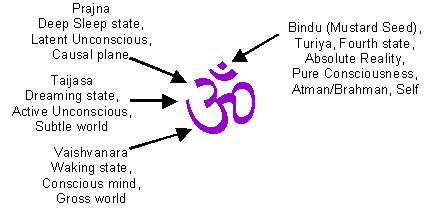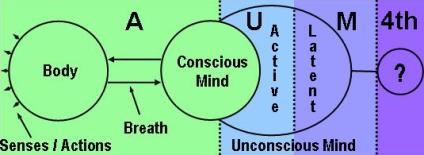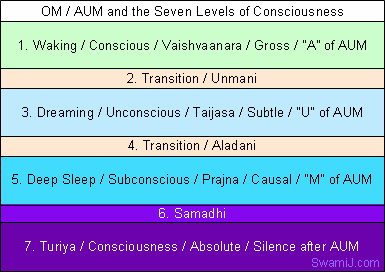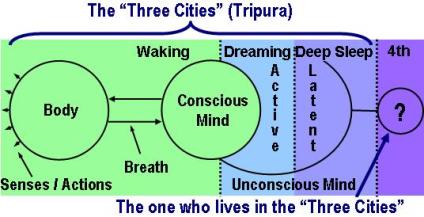|
|
||||||||||
|
|
Online Courses from Swami Jnaneshvara and Abhyasa Ashram
Yoga
Sutras 1.23-1.29:
|
|||||||||
| See also the article: Bindu: Pinnacle of Yoga, Vedanta and Tantra |
|
| Video animation of
the chakras of Sri Yantra (19 seconds): |
1.23
From a special process of devotion and letting go into the creative source
from which we emerged (ishvara pranidhana), the coming of samadhi is
imminent.
(ishvara pranidhana va)
- ishvara = creative source, pure consciousness, purusha, God, supreme Guru or teacher
- pranidhana = practicing the presence, sincerity, dedication, devotion, surrender of fruits of practice
- va = or
Through the sincere, dedicated, and
devoted practice towards the pure consciousness known by words such as purusha, God, or Guru, which is symbolized by AUM, the results of samadhi
come more quickly. In other words, the practice of following AUM through
the levels of reality and consciousness is a short cut of sorts, meaning
direct route to the center of consciousness. This can be better understood
by a close reading of these articles:
OM and the 7 Levels of Consciousness
OM and 7 Methods of Practice
Meaning of Ishvara: In the Upanishads, the word Īśvara is used to denote a state of collective consciousness. Thus, God is not a being that sits on a high pedestal beyond the sun, moon, and stars; God is actually the state of Ultimate Reality. But due to the lack of direct experience, God has been personified and given various names and forms by religions throughout the ages. When one expands one's individual consciousness to the Universal Consciousness, it is called Self-realization, for the individual self has realized the unity of diversity, the very underlying principle, or Universal Self, beneath all forms and names. The great sages of the Upanishads avoid the confusions related to conceptions of God and encourage students to be honest and sincere in their quests for Self-realization. Upanishadic philosophy provides various methods for unfolding higher levels of truth and helps students to be able to unravel the mysteries of the individual and the universe. (from Swami Rama in the section What God Is from Enlightenment Without God)
1.24
That creative source (ishvara) is a particular consciousness (purusha)
that is unaffected by colorings (kleshas), actions (karmas), or results of
those actions that happen when latent impressions stir and cause those
actions.
(klesha karma vipaka ashayaih aparamristah purusha-vishesha ishvara
- klesha = colored, painful, afflicted, impure; the root klish means to cause trouble
- karma = actions,
- vipaka = fruits of, maturing, ripening
- ashayaih = by the vehicles, resting place, storage of traces, propensities, accumulations
- aparamristah = untouched, unsmeared
- purusha-vishesha = a consciousness, a special or distinct purusha (purusha = a consciousness; vishesha = special, distinct)
- ishvara = creative source, God, supreme Guru or teacher
The pure consciousness itself that is represented by AUM is not colored the way that the samskaras are commonly colored (klishta, 2.3, 2.1-2.9, 2.10-2.11). It is also not subject to the playing out of karmas, nor do actions cause the creation of new samskaras (2.12-2.25).
1.25
In that pure consciousness (ishvara) the seed of omniscience has reached
its highest development and cannot be exceeded.
(tatra niratishayam sarvajna bijam)
- tatra = there, in that (in that special purusha)
- niratishayam = unsurpassed, not exceeded by any others, limitless
- sarvajna = all knowing (sarva = all; jna = knowing)
- bijam = seed
The pure consciousness identified by AUM is also the seed of pure knowledge or omniscience. That level of knowing is sought in the practice of OM.
1.26
From that consciousness (ishvara) the ancient-most teachers were taught,
since it is not limited by the constraint of time.
(purvesham api guruh kalena anavachchhedat)
- purvesham = of the first, former, earlier, ancient
- api = too, also
- guruh = teacher
- kalena = by time
- anavachchhedat = not limited by (time), no break or division, continuous
This pure consciousness, being eternal in nature, is the direct teacher of all of the ancient, earlier, or even the first of the teachers within humanity. In other words, some of the original teachers of humanity have learned directly from this pure consciousness, not from a human lineage of teacher-student, etc., whereby there is just a passing of information. This direct learning from the source continues to be available at all times and places, though the help of human teachers is surely a useful, if not essential aid.
1.27
The sacred word designating this creative source is the sound OM, called
pranava.
(tasya vachakah pranavah)
- tasya = of that
- vachakah = designator, signifier, indicator, term
- pranavah = the mantra AUM or OM
AUM has a vibrational quality along with other meanings, one of which is as a designator or term to denote the pure consciousness referred to in the sutras above. The word pranavah literally translates as "humming."
See also the articles:
OM and the 7 Levels of Consciousness
OM and 7 Methods of Practice

The lower curve represents the Gross, Conscious, and Waking state level, called Vaishvanara.
The center curve represents the Subtle, Unconscious, and Dreaming level, called Taijasa.The upper curve represents the Causal, Subconscious, and Deep Sleep level, called Prajna.
The dot, point, or bindu represents the fourth state, the absolute consciousness, which encompasses, permeates, and is the other three, and is called Turiya.
The arc below the dot symbolizes the separateness of this fourth state, standing above, though ever remaining part of the other three.
| See also the article: Bindu: Pinnacle of Yoga, Vedanta and Tantra |
1.28
This sound is remembered with deep feeling for the meaning of what it
represents.
(tat japah tat artha bhavanam)
- tat = its
- japah = repeated remembrance
- tat = its
- artha = meaning
- bhavanam = understanding with feeling, absorbing, dwelling upon
It is important to remember not only the vibration (japa), but also the deep meaning of the mantra, rather than to perform merely parrot-like repetition in the mind.
See also these articles:
How to Use a Mantra
OM and 7 Methods of Practice
1.29
From that remembering comes the realization of the individual Self and the
removal of obstacles.
(tatah pratyak chetana adhigamah api antaraya abhavash cha)
- tatah = thence
- pratyak = individual
- chetana = consciousness
- adhigamah = understanding, realization, attainment
- api = also
- antaraya = of obstacles or impediments
- abhavash = absence, disappearance, removal
- cha = and, also
Two direct benefits come from the proper practice of the OM mantra:
- Obstacles will be removed (1.30-1.32).
- It is a direct route to Self-realization.
If one is able to sincerely, devotedly, intensely practice the AUM mantra in the depth of its meaning, it is a complete practice unto itself.
| See also the article: Bindu: Pinnacle of Yoga, Vedanta and Tantra |
------- This site is devoted to
presenting the ancient Self-Realization path of
the Tradition of the Himalayan masters in simple, understandable and
beneficial ways, while not compromising quality or depth. The goal of
our sadhana or practices is the highest
Joy that comes from the Realization in direct experience of the
center of consciousness, the Self, the Atman or Purusha, which is
one and the same with the Absolute Reality.
This Self-Realization comes through Yoga meditation of the Yoga
Sutras, the contemplative insight of Advaita Vedanta, and the
intense devotion of Samaya Sri Vidya Tantra, the three of which
complement one another like fingers on a hand.
We employ the classical approaches of Raja, Jnana, Karma, and Bhakti
Yoga, as well as Hatha, Kriya, Kundalini, Laya, Mantra, Nada, Siddha,
and Tantra Yoga. Meditation, contemplation, mantra and prayer
finally converge into a unified force directed towards the final
stage, piercing the pearl of wisdom called bindu, leading to the
Absolute.




